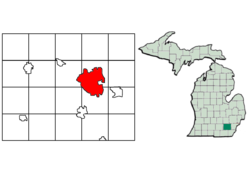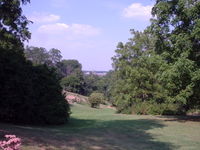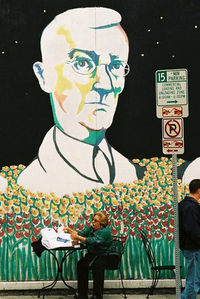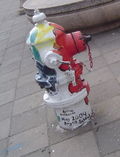Ann Arbor, Michigan
2007 Schools Wikipedia Selection. Related subjects: North American Geography
| Ann Arbor, Michigan | |||
|
|||
| Nickname: "A-squared, Ace Deuce, A-2" | |||
| Location of Ann Arbor within Washtenaw County, Michigan. | |||
| Coordinates: | |||
|---|---|---|---|
| Country | United States | ||
| State | Michigan | ||
| County | Washtenaw | ||
| Mayor | John Hieftje | ||
| Area | |||
| - City | 71.7 km² (27.7 sq mi) | ||
| - Land | 70.0 km² (27.0 sq mi) | ||
| - Water | 1.7 km² (0.7 sq mi) | ||
| Elevation | 256 m (840 ft) | ||
| Population | |||
| - City (2000) | 114,024 (city proper) | ||
| - Density | 1,629.9/km² (4,221.1/sq mi) | ||
| Time zone | EST ( UTC-5) | ||
| - Summer ( DST) | EDT ( UTC-4) | ||
| Website: www.ci.ann-arbor.mi.us | |||
Ann Arbor is a city in the U.S. state of Michigan and the county seat of Washtenaw County. As of the 2000 census, the city had a total population of 114,024, of which 36,892 (32%) are college or graduate students. Supposedly named for the spouses of the city's founders and for the stands of trees in the area, Ann Arbor is best known as the location of the main campus of the University of Michigan, which moved there from Detroit in 1837.
The city's economy, which was once noted for production of agricultural implements, carriages, furniture, pianos and organs, pottery, and flour, is now dominated by education, high-tech, and biotechnology. Average home prices and property taxes are well above the state and national medians. The city is also well known locally as a destination for dining out and entertainment, as it contains a wide and eclectic variety of restaurants and performance venues.
History
| Historical populations | ||
|---|---|---|
| Census | Pop. | %± |
|
|
||
| 1860 | 5,097 |
|
| 1870 | 7,363 | 44.5% |
| 1880 | 8,061 | 9.5% |
| 1890 | 9,431 | 7.0% |
| 1900 | 14,509 | 53.8% |
| 1910 | 14,817 | 2.1% |
| 1920 | 19,516 | 31.7% |
| 1930 | 26,944 | 38.1% |
| 1940 | 29,815 | 10.7% |
| 1950 | 48,251 | 61.8% |
| 1960 | 67,340 | 39.6% |
| 1970 | 100,035 | 48.6% |
| 1980 | 107,969 | 7.9% |
| 1990 | 109,592 | 1.5% |
| 2000 | 114,024 | 4.0% |
Ann Arbor was founded in January 1824 by John Allen and Elisha Rumsey, both of whom were land speculators. There are various accounts concerning the origin of the settlement's name, but one states that Allen and Rumsey decided to name it "Ann'sarbour" for their spouses, both named Ann, and for the stands of burr oak in the 640 acres (260 ha) of land they had purchased for $800 from the federal government. The Native Americans of the region knew the settlement as Kaw-goosh-kaw-nick, after the sound of Allen's grist mill.
Ann Arbor later became the seat of Washtenaw County in 1827, and was incorporated as a village in 1833. The town set aside 40 acres (16 hectares) of undeveloped land and offered it to the State of Michigan as the site of the state capitol, but it lost the bid to Lansing in 1836. In 1837 the unused land was given to the University of Michigan, forever linking Ann Arbor and its history with the university. The town became a regional transportation hub in 1839 with the arrival of the Michigan Central Railroad. Ann Arbor was chartered as a city in 1851.
During World War II, Ford Motor Company's nearby Willow Run plant turned out B-24 Liberator bombers. The population of Ann Arbor exploded with an influx of military personnel, war workers, and their families.
The city gained a reputation as an important centre for liberal politics over the course of the 1960s and 1970s. Presidential candidate John F. Kennedy unveiled his Peace Corps proposal in 1960 at the University of Michigan, and there in 1964 President Lyndon B. Johnson first called for a " Great Society." The city also became a locus for left-wing activism, serving as a hub for the civil-rights movement and anti-Vietnam War movement, as well as the student movement. The first major meetings of the national left-wing campus group Students for a Democratic Society took place in Ann Arbor in 1960, and in 1965 the city was home to the first U.S. teach-in against the Vietnam War. Over the course of the ensuing fifteen years, a plethora of countercultural and New Left enterprises sprang up and developed strong constituencies within the city.
These influences washed into municipal politics during the early and mid-1970s when three members of the local, progressive Human Rights Party (HRP) won city-council seats on the strength of the student vote. During their time on the council, HRP representatives successfully fought for measures ranging from pioneering antidiscrimination ordinances to measures decriminalizing marijuana possession to a rent-control ordinance – many of which remain in effect in modified form today.
Alongside these liberal and left-wing efforts, a small handful of conservative institutions were also born in Ann Arbor. These include Word of God (established in 1967), a charismatic inter-denominational movement of national scope; and the Thomas More Law Centre (established in 1999), a leading religious-conservative advocacy group.
The economy of Ann Arbor underwent a gradual shift from a manufacturing base to a service and technology base over the course of the 20th century, a shift which accelerated in the 1970s and 1980s. At the same time, the downtown has transformed from one dominated primarily by retail establishments dealing in staple goods to one comprised mainly of eateries, cafés, bars and clubs, and specialty shops.
Over the past several decades, the city has increasingly found itself grappling with the effects of sharply rising land values and gentrification, as well as urban sprawl stretching far into the outlying countryside. On November 2, 2004, voters approved a greenbelt plan under which the city government would buy development rights to pieces of land adjacent to Ann Arbor to preserve them from sprawling development. Since then, a vociferous local debate has hinged on whether, and how, to accommodate and guide development within city limits.
Geography and climate
According to the United States Census Bureau, the city has a total area of 27.7 square miles (71.7 km²); 27.0 square miles (70.0 km²) of it is land and 0.7 square miles (1.7 km²) or 2.42% of it is water, much of which is part of the Huron River. Ann Arbor is approximately 40 miles (64 km) west of Detroit, a 45-minute car ride on I-94. Ann Arbor Charter Township is adjacent, on the city's north and east sides.
Ann Arbor is situated on the Huron River, in a productive agricultural and fruit-growing region. The landscape of Ann Arbor consists of rolling hills and valleys, with the terrain becoming steeper near the Huron River. The elevation ranges from about 750 feet (230 m) along the Huron River to about 900 feet (275 m) above sea level in southern and northeastern Ann Arbor. The elevation is about 839 feet (256 m) at Ann Arbor Municipal Airport, which is located at .
Cityscape
Ann Arbor's "Tree Town" moniker stems from the dense forestation of its parks and residential areas. The city holds almost as many trees as residents, with more than 50,000 trees sited along city streets and an equal number in city parks. In recent years, the emerald ash borer has destroyed many of the city's approximately 10,500 ash trees.
The city contains 147 municipal parks, ranging from neighbourhood vest-pocket parks to large recreation areas, with several large city parks and a university park bordering sections of the Huron River. The largest are Argo Park, Riverside Park, County Farm Park, and Gallup Park (near the Huron Parkway), while Fuller Recreation Area, near the University Hospital complex, contains sports fields, pedestrian and bike paths, and swimming pools. Nichols Arboretum, which is jointly owned by the City of Ann Arbor and the University of Michigan (and known locally as "The Arboretum" or just "The Arb"), is a 123-acre (50 hectare) preserve containing hundreds of plant and tree species on the east side of the city near downtown.
The Kerrytown Shops, Main Street Business District, the State Street Business District, and the South University Business District are commercial areas in downtown. Three commercial areas south of downtown include the areas near I-94 and Ann Arbor-Saline Road, Briarwood Mall, and the South Industrial area. Other commercial areas include the Arborland/Washtenaw Avenue and Packard Road merchants on the east side, the Plymouth Road area in the northeast, and the Westgate/West Stadium areas on the west side. The downtown contains a mix of 19th and early 20th-century structures and modern-style buildings, as well as a farmers' market in the Kerrytown district. The city's commercial districts are mostly comprised of two to four-story structures, although the downtown and the area near Briarwood Mall contain a small number of high-rise buildings.
Ann Arbor's residential neighborhoods contain a range of architectural styles, from classic 19th and early 20th-century designs to ranch-style houses. More contemporary-style houses are located farther from the downtown district. Surrounding the University of Michigan campus are houses and apartment complexes occupied primarily by student renters. The 19th-century buildings and streetscape of the Old West Side neighbourhood have been preserved virtually intact; in 1972, the district was listed on the National Register of Historic Places, and it is further protected via city ordinances and a nonprofit preservation group.
Climate
Ann Arbor has a typically Midwestern temperate seasonal climate, which is influenced by the Great Lakes. There are four seasons, with winters being cold with moderate snowfall while summers can be warm and humid. The area does experience lake effect, primarily in the form of increased cloudiness during late fall and early winter. The highest average temperature is in July at 83 ° F (28 ° C) while the lowest average temperature is in January at 16 °F (−9 °C). However, summer temperatures can top 90 °F (32 °C), and winter temperatures can drop below 0 °F (−17 °C). Average monthly precipitation ranges from 2 to 4 inches (44 to 92 mm), with the heaviest occurring during the summer months. Snowfall, which normally occurs from November to April, ranges from 1 to 10 inches (3 to 25 cm) per month. The highest recorded temperature was 105 °F (40.6 °C) on July 24, 1934, while the lowest recorded temperature was −22.0 °F (−30 °C) on January 19, 1994.
Demographics
As of the census ² of 2000, there were 114,024 people, 45,693 households, and 21,704 families residing in the city. The population density was 4,221.1 people per square mile (1,629.9/km²). There were 47,218 housing units at an average density of 1,748.0 per square mile (675.0/km²), making it less dense than inner-ring Detroit suburbs (and Detroit proper itself) like Oak Park and Ferndale, but denser than outer-ring suburbs like Livonia. The racial makeup of the city was 74.68% White, 8.83% Black or African American, 0.29% Native American, 11.90% Asian, 0.04% Pacific Islander, 1.21% from other races, and 3.05% from two or more races. 3.34% of the population were Hispanic American or Latino of any race. Because of the pull of the university, the city has one of the highest foreign-born population percentages in the state sitting at 16.6%.
There were 45,693 households out of which 23.0% had children under the age of 18 living with them, 37.8% were married couples living together, 7.5% had a female householder with no husband present, and 52.5% are nonfamilies. 35.5% of all households were made up of individuals and 6.6% had someone living alone who was 65 years of age or older. The average household size was 2.22 and the average family size was 2.90.
In the city the population was spread out with 16.8% under the age of 18, 26.8% from 18 to 24, 31.2% from 25 to 44, 17.3% from 45 to 64, and 7.9% who were 65 years of age or older. The median age was 28 years. For every 100 females there were 97.7 males. For every 100 females age 18 and over, there were 96.4 males.
The median income for a household in the city was $46,299, and the median income for a family was $71,293. Males had a median income of $48,880 versus $36,561 for females. The per capita income for the city was $26,419. About 4.6% of families and 16.6% of the population were below the poverty line, including 7.3% of those under age 18 and 5.1% of those age 65 or over.
Ann Arbor's crime rate is below the national average. Compared with that average, the violent crime rate is much lower than the property crime rate: 50% and 26% less than the national average, respectively.
| Violent and property crime statistics | |
|---|---|
 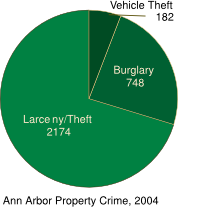 |
|
| Comparison with national averages | |
   |
|
Law and government
Ann Arbor has a mayor- council form of government. The mayor, who is elected every even-numbered year, is the presiding officer of the City Council and has the power to appoint all Council committee members as well as board and commission members, with the approval of the City Council. The City Council has ten members, two from each of the city's five wards, with the mayor wielding the tie-breaking vote. Council members serve two-year terms, with half the council elected in annual elections.
Ann Arbor is located in the 15th Congressional district, and is represented by Representative John Dingell ( D), the longest-serving member of the U.S. House. On the state level, the city is in the 18th district in the Michigan Senate. In the Michigan State House of Representatives, the city of Ann Arbor is in the 53rd district, while northeastern Ann Arbor and Ann Arbor Township are in the 52nd district. As the seat of Washtenaw County, the city is the location of the county's trial, civil, and criminal courts. Ann Arbor is also the site of a United States district court, whose downtown building also houses a post office.
Left-wing politics have been particularly strong in municipal government since the 1960s – an orientation evident in the passage of rent-control and strong antidiscrimination ordinances, as well as voter-approved charter amendments that have lessened the penalties for possession of marijuana (1974) and that aim to protect access to abortion in the city should it ever become illegal in the State of Michigan (1990). In 1974, Kathy Kozachenko's victory in an Ann Arbor city-council race made her the country's first openly gay or lesbian candidate to win public office. In 1975, Ann Arbor became the first U.S. city to use instant-runoff voting for a mayoral race. Adopted through a ballot initiative sponsored by the local Human Rights Party, which feared a splintering of the left/liberal vote, the process was repealed in 1976 after use in only one election. As of February 2006, Democrats hold the mayorship and all ten council seats. The city is often considered to be the most liberal area of Michigan.
Sister cities
Ann Arbor has seven sister cities around the world:
 - Tübingen, Germany, since 1965
- Tübingen, Germany, since 1965 - Belize City, Belize, since 1967
- Belize City, Belize, since 1967 - Hikone, Japan, since 1969
- Hikone, Japan, since 1969 - Peterborough, Ontario since 1983
- Peterborough, Ontario since 1983 - Juigalpa, Nicaragua, since 1986
- Juigalpa, Nicaragua, since 1986 - Dakar, Senegal, since 1997
- Dakar, Senegal, since 1997 - Remedios, Cuba, since 2003
- Remedios, Cuba, since 2003
Economy
The University of Michigan shapes Ann Arbor's economy, both directly and indirectly. It employs about 30,000 workers, including about 7,500 in the medical centre. Other employers are drawn to the area by the university's research and development money, and by its graduates. High tech, health services and biotechnology are other major components of the city's economy, with numerous medical offices, laboratories, and associated companies located within the city. Companies associated with the automobile industry, such as General Motors and Ford, also employ a large number of residents. Other major employers include Pfizer, Google, Borders Group, and Dominos.
A number of high-tech companies are located in the city. Ann Arbor Terminals was, during the 1980s, the manufacturer of a video-display terminal called the Ann Arbor Ambassador. Other high-tech companies in the area include Arbor Networks (provider of Internet traffic engineering and security systems), Arbortext (provider of XML-based publishing software), MediaSpan Media Software (provider of newspaper publishing software and ASP services), and ProQuest, which includes UMI.
Websites and online media companies located in the city include All Media Guide, Everything2, and the Weather Underground. Ann Arbor is also the site of the Michigan Information Technology Centre (MITC), whose offices also house Internet2 and the Merit Network, a nonprofit research and education computer network. On July 11, 2006, Google announced plans to open a 1000-employee Ann Arbor office for its AdWords program later in the year.
Pfizer, the city's second largest employer, operates a large pharmaceutical research facility on the northeast side of town. The facility was previously operated by Warner-Lambert and, before that, Parke-Davis. The city is the home of other research and engineering centers, including those of General Dynamics and the National Oceanic and Atmospheric Administration (NOAA). Other research centers sited in the city are the Environmental Protection Agency's National Vehicle and Fuel Emissions Laboratory and the Toyota Technical Centre.
Ann Arbor serves as the headquarters to several major companies. The original Borders Books was opened on Ann Arbor's State Street in 1971 by brothers Tom and Louis Borders, and began operating other outlets around the region beginning in 1985. The Borders chain is still based in the city, as is its flagship store (although not in its original location). Dogs are allowed inside the flagship store, and the cashiers have a stock of treats for such visitors. Domino's Pizza's headquarters are in Ann Arbor on Domino's Farms, a 271-acre (109 hectare) Frank Lloyd Wright-inspired complex in the northeastern portion of the city. Flint Ink Corp., another Ann Arbor-based company, was until recently the world's largest privately held ink manufacturer (in October 2005 it was acquired by Stuttgart-based XSYS Print Solutions). Another Ann Arbor-based company is Zingerman's Delicatessen, which serves sandwiches and Jewish foods, and has derived and developed a variety of businesses under different brand names.
Many cooperative enterprises were founded in the city during the 1960s and 1970s; among those that survive today are the People's Food Co-op and the Inter-Cooperative Council at the University of Michigan, a student-housing cooperative. The North American Students of Cooperation (NASCO) is an association of cooperatives, headquartered in Ann Arbor. There are also three cohousing communities ( Sunward, Great Oak, Touchstone) located just outside the city limits to the west.
Education
The University of Michigan is the dominant institution of higher learning in Ann Arbor, providing the city with a distinctly college-town atmosphere. Much of the campus is adjacent to and intermixed with the city's downtown district. Because the campus and the city expanded side-by-side, there is often no firm divide between the two, with university buildings scattered through much of the city centre.
Other colleges and universities located in the city are Cleary University, a private business school; Concordia University, a Lutheran liberal-arts institution; and Washtenaw Community College. Ave Maria School of Law, a Catholic institution established by Domino's Pizza cofounder Tom Monaghan, opened in northeastern Ann Arbor in 2000. There were plans to establish Ave Maria University on land occupied by Domino's Farms. However, due to conflicts with local zoning authorities, the new campus is under construction near Naples, Florida.
The Ann Arbor Public School District – which enrolls a total of 16,885 students (2004/2005 September head count) – consists of twenty-one elementary schools, five middle schools, and five high schools (two traditional, Pioneer and Huron, as well as three alternative schools: Community High, Stone School, and Roberto Clemente). The district operates a K-8 open school program, Ann Arbor Open, out of the former Mack School. This program is open to all families who live anywhere in the district. Ann Arbor Public Schools also operates a preschool and family centre with programs starting as early as birth for at-risk infants and other programs for at-risk children before kindergarten. The district has constructed a new preschool centre to open in September 2006, with both free and tuition-based programs for all preschoolers in the district.
Due to overcrowding problems at the two traditional high schools, a third traditional high school is under construction. Originally slated to open for the fall of 2007, the school is now slated to open in September 2008.
Culture
Ann Arbor has a number of cultural attractions and events, many sponsored by the University of Michigan. Numerous performing arts groups and facilities are located on the university's campus, as are museums dedicated to art, archaeology, and natural history and sciences (see Museums at the University of Michigan). The Matthaei Botanical Gardens, located on the northeastern edge of Ann Arbor, is operated by the university. Performing arts groups not associated with the university include the Ann Arbor Civic Theatre; the Arbor Opera Theatre; the Ann Arbor Symphony Orchestra; the Ann Arbor Ballet Theatre; the Ann Arbor Civic Ballet (established in 1954), which was Michigan's first chartered ballet company; and Performance Network, which operates a downtown theatre frequently offering new or nontraditional plays.
The Ann Arbor Hands-On Museum, located in a renovated and expanded historic downtown fire station, contains more than 250 interactive exhibits featuring science and technology. Artrain, located on North Main Street, is a traveling art museum located on a train. A number of other art galleries exist in the city, notably in the downtown area and around the University of Michigan campus.
Near the State Street area are three major theaters: the State Theatre, the University of Michigan's Hill Auditorium, and the Michigan Theatre, a renovated 1920s movie palace that hosts live performances, independent films, and classic movies. It also serves as the home for the Ann Arbor Symphony Orchestra In the Main Street area, the Ark hosts folk and acoustic music, while a number of smaller venues and nightclubs serve up jazz and other live music. The Main Street area, as well as South State Street and South University Avenue, is also the centre of a large restaurant scene in the city.
Among U.S. cities, Ann Arbor ranks first in the number of booksellers and books sold per capita. The Ann Arbor District Library has four branch outlets in addition to its main downtown building, and a fifth branch is set to open in 2008. The city is also home to the Gerald R. Ford Presidential Library.
Ann Arbor is known for college sports, notably at the University of Michigan, a member of the Big Ten Conference. Several well-known college sports facilities exist in the city, including Michigan Stadium(The Big House). Theoretically on college football game days, Ann Arbor can become Michigan's second most populous city (114,000 Ann Arbor residents plus the 110,000 seating capacity at Michigan Stadium). Crisler Arena and Yost Ice Arena play host to the school's basketball and ice hockey teams, respectively. Concordia University, a member of the NAIA, also fields sports teams.
A person from Ann Arbor is called an "Ann Arborite," and many long-time residents call themselves "townies." The city itself is often called A² ("A-squared") or A2 ("A two"), and less commonly Tree Town (or, usually tongue-in-cheek, The People's Republic of Ann Arbor). Recently, some youth have taken to calling Ann Arbor Ace Deuce or simply The Deuce. Ann Arbor is also referred to as "28 square miles surrounded by reality" a phrase originally coined by Wisconsin Governor Lee Dreyfus to describe Madison, Wisconsin.
Events
A number of annual events – many of them centered on performing and visual arts – draw visitors to Ann Arbor from around the state and the region. The Ann Arbor Folk Festival, an annual benefit concert held in late January for the Ark, features many folk musicians. The Ann Arbor Film Festival is held for six days in March at the Michigan Theatre. EdgeFest is a multi-venue festival of avant-garde and progressive jazz, held each autumn since 1997.
One unorthodox annual event is Hash Bash. Held on the first Saturday of April since 1971, the Hash Bash is an event in support of the reform of marijuana laws. It includes speeches, live music, street vending, and occasional civil disobedience. Another unorthodox event is the Naked Mile. Since 1986, it has featured students running naked through the streets in late April to celebrate the end of the winter semester. Originally police blocked off the streets to allow the run, but beginning in 2000, a crackdown by university and city police citing safety concerns has forced participants to adapt, with the event appearing in various reduced forms since.
Many large-scale events occur during the summer months. These include the Taste of Ann Arbor, a one-day event held during the first week of June in the downtown area; and the Ann Arbor Summer Festival, a three-and-a-half-week series of concerts, plays, and films typically held from mid-June through early July at the Power Centre and atop the adjacent parking structure, which is host to the free "Top of the Park" events. In 2006 the "Top of the Park" events were moved from the top of the Power Centre parking structure to a nearby courtyard near Rackham building due to construction.
The Ann Arbor Art Fairs, a set of four concurrent juried fairs held on downtown streets, began in 1960. Scheduled on Wednesday through Saturday in the third week of July, the fairs draw upward of half a million visitors from across the nation. The oldest and most competitive of the four fairs is the Ann Arbor Street Art Fair.
Other summertime events include the Blues and Jazz Festival (established in 1969), which is usually held in mid-September at Gallup Park and also at various venues around town. The Dexter-Ann Arbor Run is a running race from Dexter to downtown Ann Arbor along the Huron River. In late August the Shopping Cart Race, an unofficial and somewhat underground competition, has been held since 1998 as part of the annual Seize the Week series of events, known through 2004 as "Punk Week".
Infrastructure
Health and medicine
The University of Michigan Medical Centre, the preeminent health facility in the city, is considered one of the nation's best hospitals, taking the #11 slot in the 2005 U.S. News and World Report. The University of Michigan Health System (UMHS) includes University Hospital, C.S. Mott Children's Hospital and Women's Hospital in its core complex. UMHS also operates out-patient clinics and facilities throughout the city. The area's other major medical centers include a large facility operated by the Department of Veterans Affairs in Ann Arbor and Saint Joseph Mercy Hospital in nearby Ypsilanti.
Transportation
The city is belted by three highway-grade roadways: I-94 (which runs along the southern portion of the city), US 23 (which primarily runs along the eastern edge of Ann Arbor), and M-14 (which runs along the northern edge of the city).
The streets in downtown Ann Arbor conform to a grid pattern, though this pattern is less apparent in the surrounding areas. Several major roads branch out from the downtown district like spokes on a wheel to the highways surrounding the city. Some of the major surface arteries lead to the I-94/M-14 juncture in the west, US 23 in the east, and the city's southern areas. Also, a large network of bike paths crisscrosses the city.
The Ann Arbor Transportation Authority (AATA), which brands itself as "The Ride," operates public bus services throughout Ann Arbor and nearby Ypsilanti. A separate free bus service operates within the University of Michigan campuses. Plans have been floated several times to operate a trolley service between downtown and Briarwood Mall along disused rail tracks, although these have not come to fruition as of 2005. A downtown bus depot served by Greyhound Lines provides out-of-town bus service, and is the city's only remaining example of the Streamline Moderne architectural style.
Ann Arbor Municipal Airport is a small aircraft general aviation facility located south of I-94. Detroit Metropolitan Airport, the area's large international airport, is located about 28 miles (45 km) east of the city, in Romulus. Additionally, Willow Run Airport in nearby Ypsilanti serves freight, corporate, and general aviation clients.
The city was a major rail hub, notably for freight traffic between Toledo and ports north of Chicago, Illinois, from 1878 to 1982, though the Ann Arbor Railroad also sold 1.1 million passenger tickets in 1913 alone. The city was also served by the Michigan Central Railroad starting in 1837. Currently, Amtrak provides service to Ann Arbor, operating its Wolverine three times daily in each direction between Chicago and Pontiac, via Detroit. Rail service is provided at the Ann Arbor Train Station; the present-day station neighbors the city's old Michigan Central Depot, which was renovated as a restaurant in 1969. There have been plans to build a commuter rail link between Ann Arbor and Detroit, with the U.S. federal government providing $100 million to enable its development.
Utilities
The city provides sewage disposal and water supply services, with water coming from the Huron River and groundwater sources. There are two water-treatment plants, one main and three outlying reservoirs, four pump stations, and two elevated tanks. These facilities serve the city, which is divided into five water districts. Along with these facilities, the city's water department also operates four dams along the Huron River, two of which provide hydroelectric power. The city also offers waste management services, with recycling being handled by Recycle Ann Arbor. Other utilities are primarily provided by private entities. Electrical power and gas are provided by DTE Energy, Consumers Energy, and MichCon. AT&T, the successor to Michigan Bell, Ameritech, and SBC Communications, is the primary wired telephone service provider for the area. Phone service is also available from various national wireless companies. Cable service is primarily provided by Comcast.


